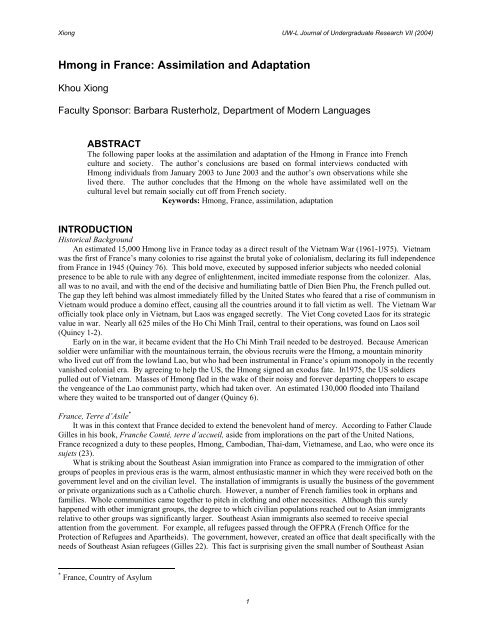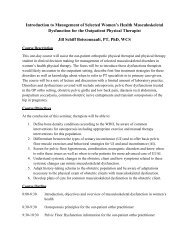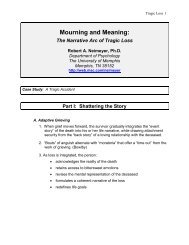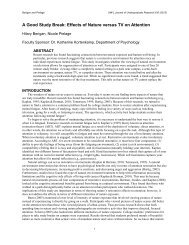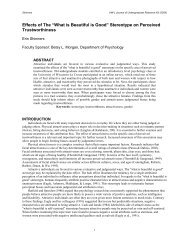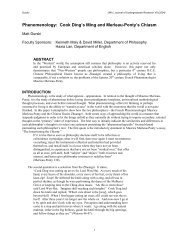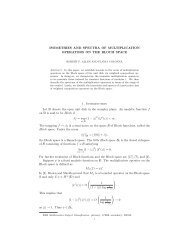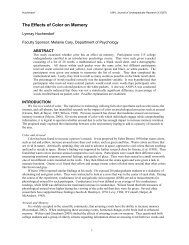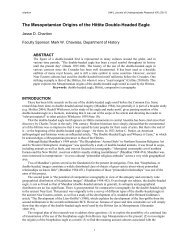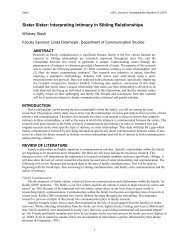Hmong in France: Assimilation and Adaptation - University of ...
Hmong in France: Assimilation and Adaptation - University of ...
Hmong in France: Assimilation and Adaptation - University of ...
You also want an ePaper? Increase the reach of your titles
YUMPU automatically turns print PDFs into web optimized ePapers that Google loves.
Xiong UW-L Journal <strong>of</strong> Undergraduate Research VII (2004)<br />
<strong>Hmong</strong> <strong>in</strong> <strong>France</strong>: <strong>Assimilation</strong> <strong>and</strong> <strong>Adaptation</strong><br />
Khou Xiong<br />
Faculty Sponsor: Barbara Rusterholz, Department <strong>of</strong> Modern Languages<br />
ABSTRACT<br />
The follow<strong>in</strong>g paper looks at the assimilation <strong>and</strong> adaptation <strong>of</strong> the <strong>Hmong</strong> <strong>in</strong> <strong>France</strong> <strong>in</strong>to French<br />
culture <strong>and</strong> society. The author’s conclusions are based on formal <strong>in</strong>terviews conducted with<br />
<strong>Hmong</strong> <strong>in</strong>dividuals from January 2003 to June 2003 <strong>and</strong> the author’s own observations while she<br />
lived there. The author concludes that the <strong>Hmong</strong> on the whole have assimilated well on the<br />
cultural level but rema<strong>in</strong> socially cut <strong>of</strong>f from French society.<br />
Keywords: <strong>Hmong</strong>, <strong>France</strong>, assimilation, adaptation<br />
INTRODUCTION<br />
Historical Background<br />
An estimated 15,000 <strong>Hmong</strong> live <strong>in</strong> <strong>France</strong> today as a direct result <strong>of</strong> the Vietnam War (1961-1975). Vietnam<br />
was the first <strong>of</strong> <strong>France</strong>’s many colonies to rise aga<strong>in</strong>st the brutal yoke <strong>of</strong> colonialism, declar<strong>in</strong>g its full <strong>in</strong>dependence<br />
from <strong>France</strong> <strong>in</strong> 1945 (Qu<strong>in</strong>cy 76). This bold move, executed by supposed <strong>in</strong>ferior subjects who needed colonial<br />
presence to be able to rule with any degree <strong>of</strong> enlightenment, <strong>in</strong>cited immediate response from the colonizer. Alas,<br />
all was to no avail, <strong>and</strong> with the end <strong>of</strong> the decisive <strong>and</strong> humiliat<strong>in</strong>g battle <strong>of</strong> Dien Bien Phu, the French pulled out.<br />
The gap they left beh<strong>in</strong>d was almost immediately filled by the United States who feared that a rise <strong>of</strong> communism <strong>in</strong><br />
Vietnam would produce a dom<strong>in</strong>o effect, caus<strong>in</strong>g all the countries around it to fall victim as well. The Vietnam War<br />
<strong>of</strong>ficially took place only <strong>in</strong> Vietnam, but Laos was engaged secretly. The Viet Cong coveted Laos for its strategic<br />
value <strong>in</strong> war. Nearly all 625 miles <strong>of</strong> the Ho Chi M<strong>in</strong>h Trail, central to their operations, was found on Laos soil<br />
(Qu<strong>in</strong>cy 1-2).<br />
Early on <strong>in</strong> the war, it became evident that the Ho Chi M<strong>in</strong>h Trail needed to be destroyed. Because American<br />
soldier were unfamiliar with the mounta<strong>in</strong>ous terra<strong>in</strong>, the obvious recruits were the <strong>Hmong</strong>, a mounta<strong>in</strong> m<strong>in</strong>ority<br />
who lived cut <strong>of</strong>f from the lowl<strong>and</strong> Lao, but who had been <strong>in</strong>strumental <strong>in</strong> <strong>France</strong>’s opium monopoly <strong>in</strong> the recently<br />
vanished colonial era. By agree<strong>in</strong>g to help the US, the <strong>Hmong</strong> signed an exodus fate. In1975, the US soldiers<br />
pulled out <strong>of</strong> Vietnam. Masses <strong>of</strong> <strong>Hmong</strong> fled <strong>in</strong> the wake <strong>of</strong> their noisy <strong>and</strong> forever depart<strong>in</strong>g choppers to escape<br />
the vengeance <strong>of</strong> the Lao communist party, which had taken over. An estimated 130,000 flooded <strong>in</strong>to Thail<strong>and</strong><br />
where they waited to be transported out <strong>of</strong> danger (Qu<strong>in</strong>cy 6).<br />
<strong>France</strong>, Terre d’Asile *<br />
It was <strong>in</strong> this context that <strong>France</strong> decided to extend the benevolent h<strong>and</strong> <strong>of</strong> mercy. Accord<strong>in</strong>g to Father Claude<br />
Gilles <strong>in</strong> his book, Franche Comté, terre d’accueil, aside from implorations on the part <strong>of</strong> the United Nations,<br />
<strong>France</strong> recognized a duty to these peoples, <strong>Hmong</strong>, Cambodian, Thai-dam, Vietnamese, <strong>and</strong> Lao, who were once its<br />
sujets (23).<br />
What is strik<strong>in</strong>g about the Southeast Asian immigration <strong>in</strong>to <strong>France</strong> as compared to the immigration <strong>of</strong> other<br />
groups <strong>of</strong> peoples <strong>in</strong> previous eras is the warm, almost enthusiastic manner <strong>in</strong> which they were received both on the<br />
government level <strong>and</strong> on the civilian level. The <strong>in</strong>stallation <strong>of</strong> immigrants is usually the bus<strong>in</strong>ess <strong>of</strong> the government<br />
or private organizations such as a Catholic church. However, a number <strong>of</strong> French families took <strong>in</strong> orphans <strong>and</strong><br />
families. Whole communities came together to pitch <strong>in</strong> cloth<strong>in</strong>g <strong>and</strong> other necessities. Although this surely<br />
happened with other immigrant groups, the degree to which civilian populations reached out to Asian immigrants<br />
relative to other groups was significantly larger. Southeast Asian immigrants also seemed to receive special<br />
attention from the government. For example, all refugees passed through the OFPRA (French Office for the<br />
Protection <strong>of</strong> Refugees <strong>and</strong> Apartheids). The government, however, created an <strong>of</strong>fice that dealt specifically with the<br />
needs <strong>of</strong> Southeast Asian refugees (Gilles 22). This fact is surpris<strong>in</strong>g given the small number <strong>of</strong> Southeast Asian<br />
* <strong>France</strong>, Country <strong>of</strong> Asylum<br />
1
Xiong UW-L Journal <strong>of</strong> Undergraduate Research VII (2004)<br />
refugees compared to refugees from African or East European countries who also flooded <strong>France</strong> at about the same<br />
time.<br />
In light <strong>of</strong> the fact that <strong>France</strong> was experienc<strong>in</strong>g a rather severe economic depression follow<strong>in</strong>g 30 years <strong>of</strong><br />
relative economic prosperity, what has been termed les trentes glorieuses (1945-1975), the positive reaction to Asian<br />
immigrant presence is even more surpris<strong>in</strong>g. The <strong>Hmong</strong> arrived at a time when xenophobic sentiments were on the<br />
rise, ma<strong>in</strong>ly <strong>in</strong> reaction to the depressed economy whose depression was perceived to be aggravated by the readily<br />
available, cheap labor <strong>of</strong> immigrants, particularly North African immigrants, who had been encouraged to migrate<br />
<strong>in</strong>to <strong>France</strong> to fill the labor gap follow<strong>in</strong>g WWII death tolls. Although immigrants <strong>of</strong> earlier periods <strong>in</strong> French<br />
history met with hostility sometimes as violent as what North Africans <strong>and</strong> the Arab population have been subjected<br />
to, the difference is that former groups—the Germans, Portuguese, Italians, Spanish—shared similar physical<br />
characteristics <strong>and</strong> a similar European culture. Any issues <strong>of</strong> “us” <strong>and</strong> “them” disappeared over time as<br />
<strong>in</strong>termarriages <strong>and</strong>/or adaptation, result<strong>in</strong>g <strong>in</strong> complete assimilation, occurred. It is worth not<strong>in</strong>g that many Africans<br />
<strong>and</strong> Southeast Asians have been <strong>in</strong> <strong>France</strong> for several decades, yet the widespread assumption that fr<strong>in</strong>ges on<br />
condemnation that they are “<strong>in</strong>assimilable” hangs over their heads. Their descendants, born on French soil,<br />
speak<strong>in</strong>g fluent French, perhaps even assimilat<strong>in</strong>g completely French culture, are still termed les immigrés † (Stovall<br />
5-10).<br />
French <strong>Assimilation</strong>ist Theory<br />
The “problem” <strong>of</strong> the <strong>in</strong>assimilability <strong>of</strong> these recent groups h<strong>in</strong>ts at a characteristic <strong>of</strong> French society that<br />
dist<strong>in</strong>guishes it from pluralist countries like Great Brita<strong>in</strong> <strong>and</strong> Canada. <strong>France</strong> does not <strong>of</strong>ficially recognize the<br />
concept <strong>of</strong> “race” or “ethnicity” (Cognet 1). In accordance with its republican universalist ideals—legacy <strong>of</strong> the<br />
French Revolution (1789-1815)—which sought to elim<strong>in</strong>ate all societal <strong>in</strong>equalities <strong>in</strong> French society, it embraces<br />
the view that all people are similar. Differences lay only <strong>in</strong> nuances <strong>in</strong> language <strong>and</strong> customs, which, fabricated by<br />
history, are “accidental <strong>and</strong> superficial” (Duffy 198). Inclusion <strong>in</strong> the French identity is, therefore, not determ<strong>in</strong>ed<br />
by race, culture, or ethnic orig<strong>in</strong>s.<br />
<strong>France</strong>’s refusal to stress particularities has traditionally justified an aggressive assimilationist policy toward its<br />
immigrants. The <strong>Hmong</strong> are no exception. In anticipation <strong>of</strong> the welcom<strong>in</strong>g <strong>of</strong> these ex-colonial subjects, <strong>France</strong><br />
put <strong>in</strong>to place an extensive welcom<strong>in</strong>g network whose pr<strong>in</strong>ciple goal was their immediate <strong>in</strong>tegration <strong>in</strong>to French<br />
culture <strong>and</strong> French society (Gilles 22). Integration naturally came easier if the refugees had had prior contact with<br />
anyth<strong>in</strong>g French. Thus, French <strong>of</strong>ficials <strong>in</strong> the refugee camps <strong>in</strong> Thail<strong>and</strong>, where the <strong>Hmong</strong> had fled to escape<br />
persecution, were <strong>in</strong>structed to accept discrim<strong>in</strong>ately persons who demonstrated a m<strong>in</strong>imal knowledge <strong>of</strong> the French<br />
language <strong>and</strong>/or who had served under the French military or civil service <strong>in</strong> Indoch<strong>in</strong>a (Gilles 25). Refugees would<br />
also be accepted if they had family already liv<strong>in</strong>g <strong>in</strong> <strong>France</strong>, or if they could prove that they were flee<strong>in</strong>g<br />
persecution.<br />
Upon the refugees’ arrival <strong>in</strong> <strong>France</strong>, Red Cross volunteers went to welcome them at the airport <strong>and</strong> took them<br />
to centers <strong>of</strong> transit. There they spent about 2 weeks gett<strong>in</strong>g medical check ups <strong>and</strong> fill<strong>in</strong>g out essential paperwork<br />
for their stay <strong>in</strong> their new home. Then they were transported to des centres provisoires d’hébergement, or temporary<br />
hous<strong>in</strong>g centers, heret<strong>of</strong>ore referred to as CPH’s, where they lived for 6 months (Gilles 27). This 6-month period<br />
was ideally the time for them to become <strong>in</strong>tegrated <strong>in</strong>to French life. They were <strong>in</strong>troduced to modern wonders like<br />
electricity, runn<strong>in</strong>g water, cook stoves, <strong>and</strong> the refrigerator. They attended class everyday to learn to read <strong>and</strong> write<br />
French. In the meantime, another organization looked for a permanent home for each family. ‡<br />
It should be stressed that although Asian immigrants <strong>in</strong> <strong>France</strong> have also come under much xenophobic attack,<br />
their experience doesn’t beg<strong>in</strong> to parallel the experiences <strong>of</strong> their Arab <strong>and</strong> African immigrant counterparts because<br />
they benefit from a favorable impression civilians have <strong>of</strong> them. The stereotype is that they are a submissive,<br />
humble, <strong>and</strong> hardwork<strong>in</strong>g people. They are <strong>France</strong>’s “model m<strong>in</strong>ority.”<br />
It has been estimated that 15,000 <strong>Hmong</strong> currently live <strong>in</strong> <strong>France</strong>. The figure should not be taken for fact as the<br />
French do not recognize the idea <strong>of</strong> a m<strong>in</strong>ority <strong>and</strong> so do not keep <strong>of</strong>ficial demographic records <strong>of</strong> their m<strong>in</strong>ority<br />
populations. Records that are made by INSEE (Institut National de la Statistique et des Etudes Economiques) erase<br />
any trace <strong>of</strong> “<strong>Hmong</strong>,” anyway, because “ethnicity” does not <strong>of</strong>ficially exist. All <strong>Hmong</strong> are <strong>of</strong>ficially Laotians.<br />
Thus, most <strong>Hmong</strong> refugees carry the <strong>of</strong>ficial nationality <strong>of</strong> “Laotian d’orig<strong>in</strong>e <strong>Hmong</strong>.” §<br />
† immigrants<br />
‡ For further read<strong>in</strong>g on immigration procedures <strong>of</strong> Southeast Asians, see Claude Gilles, Franche-Comté, terre<br />
d’accueil: Cambodgiens, Laotians, <strong>Hmong</strong>, Vietnamiens, Paris: L’Harmattan, 2000.<br />
§ Laotian <strong>of</strong> <strong>Hmong</strong> Orig<strong>in</strong>s<br />
2
Xiong UW-L Journal <strong>of</strong> Undergraduate Research VII (2004)<br />
Note that some <strong>Hmong</strong> names will also be given <strong>in</strong> <strong>Hmong</strong> spell<strong>in</strong>g to ensure correct pronunciation <strong>of</strong> the given<br />
English one.<br />
METHOD<br />
Interviews were conducted from January 2003 to June 2003 <strong>and</strong> lasted anywhere from 30 m<strong>in</strong>utes to 2 hours.<br />
Topics were: the <strong>in</strong>tegration process, the generation gap, <strong>and</strong> changes <strong>in</strong> traditional cultural practices over time.<br />
Interviews were conducted <strong>in</strong> <strong>Hmong</strong>, <strong>in</strong> English, <strong>and</strong> <strong>in</strong> French.<br />
A total <strong>of</strong> 20 <strong>in</strong>dividuals, all over the age <strong>of</strong> 18, were <strong>in</strong>terviewed. The participants came from all over <strong>France</strong>.<br />
In the north: Caen <strong>and</strong> Lisieux.; <strong>in</strong> the Paris region: Grigny, Evry, <strong>and</strong> Versailles; <strong>in</strong> the west: Cholet; <strong>and</strong> <strong>in</strong> the<br />
south: Blomec, Toulouse, <strong>and</strong> Bordeaux. Other places where no formal <strong>in</strong>terview<strong>in</strong>g was done, but where the<br />
author spent time with <strong>Hmong</strong> people are Nîmes, Gex, <strong>and</strong> Golbey.<br />
RESULTS<br />
The <strong>Hmong</strong> have been effectively dispersed all over <strong>France</strong> as a result <strong>of</strong> the efficient network <strong>of</strong> CPH’s.<br />
Unlike here <strong>in</strong> the United States where secondary migrations usually occurred as clans sought to come together, <strong>in</strong><br />
<strong>France</strong>, <strong>Hmong</strong> families usually found that once the CPH found employment for the male head <strong>of</strong> the family, it was<br />
hard to move elsewhere to follow relatives or clan members. Jobs were hard to f<strong>in</strong>d, doubly so because they spoke<br />
not a word <strong>of</strong> the language. The cultural consequences are many.<br />
A Loss <strong>of</strong> Culture<br />
Funerals<br />
The <strong>Hmong</strong> <strong>in</strong> <strong>France</strong> relative to their United States counterpart have been obliged to let go <strong>of</strong> many cultural<br />
practices <strong>and</strong> traditions because they are few <strong>in</strong> number. Many <strong>Hmong</strong> ceremonies necessitate the existence <strong>of</strong><br />
elders who know the oral traditions. An example is the funeral. A traditional funeral needs a man who can s<strong>in</strong>g the<br />
funerary songs <strong>and</strong> one who can play the qeej, a free-reed multiple pipe musical <strong>in</strong>strument, to accompany the<br />
deceased to the other world. The <strong>Hmong</strong> have found that it is not easy to keep the traditions. Few <strong>Hmong</strong> men<br />
know the oral traditions. Back <strong>in</strong> Laos, a whole community probably did not have a man who knew them. Blong<br />
Ly observes that, “<strong>in</strong> the south [<strong>of</strong> <strong>France</strong>], it’s like this—<strong>in</strong> the north, I’m not sure—but if there are funerals <strong>in</strong> the<br />
south, you see pretty much the same people perform<strong>in</strong>g the ceremonies.” The concern is that when these few men<br />
who know the oral traditions pass away, there will be no one to prepare the dead for the other world. A whole rich<br />
tradition is lost.<br />
On the other h<strong>and</strong>, the scarcity <strong>of</strong> men who know the traditions have prompted some families to turn to<br />
Christianity. As Chong Lue (Txooj Lwm) Vang put it: “The family needed a faith that could be practiced to fall<br />
back on.” Or it has prompted families to follow no specific faith. Many <strong>of</strong> the young <strong>Hmong</strong> couples rely neither<br />
on the <strong>Hmong</strong> traditions nor on Christianity. Chia (Txhiaj) Lyfoung states, “If my children are sick, to the hospital.”<br />
Other obstacles, characteristic <strong>of</strong> urban life, prevent the <strong>Hmong</strong> from practic<strong>in</strong>g fully their culture. Many<br />
<strong>Hmong</strong> families today live <strong>in</strong> huge apartment complexes that were built pr<strong>in</strong>cipally for immigrant workers <strong>in</strong> the<br />
1960’s. How does one keep the culture alive <strong>in</strong> such an environment? Make a racket with the drum beat<strong>in</strong>g dur<strong>in</strong>g<br />
the funeral <strong>and</strong> the neighbors on either side may call the police; have the shaman pound enough on the floor<strong>in</strong>g <strong>and</strong><br />
the neighbors downstairs could end up with showers <strong>of</strong> pa<strong>in</strong>t ceil<strong>in</strong>g.<br />
Where does one sacrifice the pig for a spirit call<strong>in</strong>g ceremony? Even if the pig is slaughtered at the farm, how<br />
does one cart it up 10 stories?<br />
At any <strong>Hmong</strong> celebration, friends <strong>and</strong> all the extended family members attend. How can an apartment, already<br />
cramped for the immediate family, fit everyone?<br />
These are some <strong>of</strong> the obstacles that have prompted some <strong>Hmong</strong> families to give up cultural practices like a<br />
traditional funeral <strong>and</strong> spirit call<strong>in</strong>g ceremonies, <strong>and</strong> to not even try to transfer them on to the children.<br />
A strik<strong>in</strong>g example is a conversation with a young man concern<strong>in</strong>g funerary rites. The discussion was about<br />
changes <strong>in</strong> funerary rites. The young man <strong>in</strong>sisted that noth<strong>in</strong>g had changed, that the <strong>Hmong</strong> still practiced them the<br />
way they did <strong>in</strong> Laos. When he was asked whether usage <strong>of</strong> the funeral drums <strong>and</strong> the qeej play<strong>in</strong>g was a problem<br />
to the neighbors, he became confused. He had not known that both <strong>in</strong>struments are essential to the traditional<br />
<strong>Hmong</strong> funeral.<br />
3
Xiong UW-L Journal <strong>of</strong> Undergraduate Research VII (2004)<br />
Wedd<strong>in</strong>gs<br />
Wedd<strong>in</strong>gs, <strong>in</strong> contrast to funerals, are still practiced as <strong>in</strong> the old ways with the young man tak<strong>in</strong>g the young<br />
woman home. A message is sent to the young woman’s parents that she is safely <strong>in</strong> her new home, a date for the<br />
wedd<strong>in</strong>g is set, celebrated, <strong>and</strong> the young couple becomes <strong>of</strong>ficial adult members <strong>of</strong> the community. Slight<br />
deviations occur, ma<strong>in</strong>ly <strong>in</strong> response to liv<strong>in</strong>g conditions. Sometimes families celebrate the wedd<strong>in</strong>g <strong>in</strong> a rented<br />
banquet hall or ballroom as the house may be too small. Depend<strong>in</strong>g on the f<strong>in</strong>ancial situation <strong>of</strong> the family,<br />
elaborate celebrations may occur where the young bride dresses not only <strong>in</strong> <strong>Hmong</strong> clothes, but <strong>in</strong> Laotian <strong>and</strong> <strong>in</strong> the<br />
western bridal gown. Sumptuous feast<strong>in</strong>g <strong>of</strong> roasted pig <strong>and</strong> oriental <strong>and</strong> occidental delicacies accompanied by<br />
w<strong>in</strong>e, <strong>and</strong> f<strong>in</strong>ished <strong>of</strong>f with fruits <strong>and</strong> a huge wedd<strong>in</strong>g cake for dessert may occur.<br />
The New Year<br />
The New Year celebration, like the funeral, has somewhat adapted to <strong>Hmong</strong> lifestyles. While the celebration<br />
may change from clan to clan, <strong>in</strong> general, recognition <strong>of</strong> a new year <strong>in</strong>volves sacrific<strong>in</strong>g a chicken, perform<strong>in</strong>g a<br />
small spirit call<strong>in</strong>g ceremonie, <strong>and</strong> then putt<strong>in</strong>g up a new xwm kab, or a new paper alter where the house spirit that<br />
guards the home lives. Before that, though, the community must get together <strong>and</strong> perform a lwm qaib, where<br />
everyone circles a pole, first one way to get rid <strong>of</strong> the bad karma—if the word can be employed here—than another<br />
to welcome the good karma.<br />
Discount<strong>in</strong>g those who have converted to Christianity, the <strong>Hmong</strong> <strong>in</strong> <strong>France</strong> may celebrate only aspects <strong>of</strong> the<br />
New Year or not at all. Long (Loog) Xiong <strong>of</strong> Caen says that their family kills a chicken <strong>and</strong> puts up a new xwm<br />
kab but does not perform the lwm qaib. This is due to the lack <strong>of</strong> a community that would allow for a lwm qaib.<br />
Long’s family is one <strong>of</strong> a few <strong>in</strong> Caen that has not converted to Christianity. They are the only Xiongs there, <strong>and</strong> a<br />
New Year celebration must be done among clan members. Such is the case with the families <strong>of</strong> Txhiaj Lyfoung,<br />
Nhia Bee Lo, <strong>and</strong> Laj <strong>and</strong> Nu Lyfoung’s families.<br />
In other parts <strong>of</strong> <strong>France</strong>, such as Nîmes, where the <strong>Hmong</strong> population is substantial, the case may be different.<br />
The author did not have a chance to witness the celebration nor to ask an elder there.<br />
Parent Reaction to Cultural (<strong>and</strong> Language) Loss<br />
Smaller numbers <strong>of</strong> <strong>Hmong</strong> families be<strong>in</strong>g able to live <strong>in</strong> a community have had adverse effects on cultural<br />
preservation efforts. Inevitably for the youth, ties to the <strong>Hmong</strong> culture are weak as they f<strong>in</strong>d themselves<br />
surrounded mostly by non-<strong>Hmong</strong> friends. Many cannot express themselves very fluently <strong>in</strong> <strong>Hmong</strong> although they<br />
underst<strong>and</strong> it well enough when spoken to. What is strik<strong>in</strong>g is that over half <strong>of</strong> the youth who agreed to be<br />
<strong>in</strong>terviewed felt more comfortable express<strong>in</strong>g themselves <strong>in</strong> English than <strong>in</strong> <strong>Hmong</strong>, although all <strong>of</strong> them preferred<br />
French as the language <strong>of</strong> communication.<br />
Interest<strong>in</strong>gly enough, usage <strong>of</strong> <strong>Hmong</strong> was shameful for the youth. Four young women <strong>in</strong> Caen related to the<br />
author that no youth speaks <strong>Hmong</strong>, because if one does, others look at one weird. Speak<strong>in</strong>g <strong>Hmong</strong> is considered<br />
“backwards.” Two young men added that <strong>Hmong</strong> is only for crack<strong>in</strong>g jokes when the French are around.<br />
The parents naturally regret this. Long Xiong laments, “It hurts me the most to see that my children cannot<br />
speak <strong>Hmong</strong>.” Chong Lue (Txooj Lwm) expressed regret <strong>and</strong> disappo<strong>in</strong>tment, as did Chia Lyfoung, although<br />
Chia adds, “It’s a huge loss, yes, but for my children, given the choice between learn<strong>in</strong>g English <strong>and</strong> learn<strong>in</strong>g<br />
<strong>Hmong</strong>, I would want that they learn English because this is the language that will help them <strong>in</strong> their lives.”<br />
The threat <strong>of</strong> the loss <strong>of</strong> traditions, unlike the loss <strong>of</strong> language, seems less serious to the parents. They seem to<br />
accept that this is the way it has got to be. Long stated later on <strong>in</strong> the <strong>in</strong>terview, “I underst<strong>and</strong> that the children have<br />
got to do this [let go <strong>of</strong> the <strong>Hmong</strong> language <strong>and</strong> culture] to be able to advance <strong>in</strong> French society.” Nhia Lue Vang<br />
from Grigny seconded this op<strong>in</strong>ion, stat<strong>in</strong>g, “The <strong>Hmong</strong> <strong>in</strong> <strong>France</strong> are <strong>in</strong>evitably go<strong>in</strong>g to lose <strong>Hmong</strong> traditions<br />
<strong>and</strong> the <strong>Hmong</strong> language, but it is no big deal. There are still the <strong>Hmong</strong> <strong>in</strong> Ch<strong>in</strong>a <strong>and</strong> those <strong>in</strong> Laos who preserve<br />
<strong>and</strong> will keep the traditions alive.” Both Nhia Bee Lo <strong>and</strong> Chia Lyfoung agreed with Nhia Lue.<br />
A Gap, an Impossibly Wide Gap<br />
The <strong>Hmong</strong> youth are undergo<strong>in</strong>g an experience not unlike their <strong>Hmong</strong> American counterparts. The root <strong>of</strong><br />
the problem is that both sides have such completely different mentalities. Yia Vang states that “the parents don’t<br />
underst<strong>and</strong> us. If the girls don’t do what they say, they accuse them <strong>of</strong> want<strong>in</strong>g to be just like the French….They say<br />
they are bad children who don’t listen <strong>and</strong> obey….” Neng Vang recalls: “My parents wanted me to have a <strong>Hmong</strong><br />
education. My father was not a very tender person. He was very strict <strong>and</strong> had high expectations <strong>of</strong> us [the<br />
children]. He wanted to fulfill his expectations, all rapidly done, without failure.”<br />
4
Xiong UW-L Journal <strong>of</strong> Undergraduate Research VII (2004)<br />
This pressure to conform to parent expectations <strong>in</strong> direct conflict with the <strong>in</strong>dividualism that French society<br />
promises has prompted the youth to regard their experiences <strong>in</strong> a unique light. A young man aptly termed them la<br />
génération sacrifiée, or the generation that has been sacrificed. He said:<br />
Here, <strong>in</strong> this new country, it is our parents who become the children <strong>and</strong> we, the children, who<br />
become the parents. These are paths our parents have never walked before. It’s like a wilderness.<br />
They are bl<strong>in</strong>d, lost. So we are ab<strong>and</strong>oned, left to plow our own paths, <strong>and</strong> <strong>in</strong> the end, we come<br />
out the parents, because it is we who know the language, the culture, the French system <strong>in</strong> which<br />
we exist. We are weighed down with responsibilities then: the responsibility not just for us but for<br />
them, too. It is a double edged sword, though: we become the parents <strong>in</strong> one sense <strong>and</strong> must<br />
rema<strong>in</strong> the children <strong>in</strong> another. We cannot simply do what we want as adults <strong>and</strong> as “parents.”<br />
We are tied to their expectations <strong>of</strong> us, to the culture. We cannot simply do what we want. We<br />
have been sacrificed.<br />
To sacrifice is to give up someth<strong>in</strong>g <strong>in</strong> the <strong>in</strong>terest <strong>of</strong> someth<strong>in</strong>g else, not necessarily more important, not<br />
necessarily by full free will, <strong>and</strong> most <strong>of</strong> the time, not necessarily for the betterment <strong>of</strong> the one who does it. The<br />
statement suggests that this <strong>in</strong>dividual feels tied down to <strong>Hmong</strong> culture <strong>and</strong> tradition <strong>and</strong> to the community. All the<br />
youths echoed unanimously, <strong>in</strong> one form or another, this feel<strong>in</strong>g <strong>of</strong> be<strong>in</strong>g tied down <strong>in</strong> cha<strong>in</strong>s <strong>of</strong> culture:<br />
Laj Lyfoung: “The <strong>Hmong</strong> youth see that their French friends have more freedom because they<br />
can have a studio or an apartment at 18 years <strong>of</strong> age while they [<strong>Hmong</strong> youth] can’t because it’s<br />
badly viewed to leave <strong>and</strong> live on your own….They argue with the parents <strong>and</strong> are called “laib.” **<br />
Pa Nha: “We shouldn’t have to choose between two cultures. No. We should be able to live both,<br />
choos<strong>in</strong>g the best [characteristics] <strong>of</strong> each.”<br />
Anonymous source: “I can’t marry French because my parents do not like the French….I can’t<br />
make my own choices without the consent <strong>of</strong> the family <strong>and</strong> the clan.”<br />
The gap <strong>in</strong> mentality extends to differences <strong>in</strong> op<strong>in</strong>ion <strong>of</strong> <strong>in</strong>terracial dat<strong>in</strong>g <strong>and</strong> marriage. All the youth<br />
supported the idea <strong>of</strong> marriage with French or Arabs <strong>of</strong>ten with the support that “you don’t choose who you love”<br />
(Vang, Lysay). The parents, <strong>in</strong> contrast, are strongly opposed to the idea <strong>of</strong> <strong>in</strong>terracial dat<strong>in</strong>g. They are occurr<strong>in</strong>g<br />
more <strong>and</strong> more, though, as the <strong>Hmong</strong> <strong>in</strong>tegrate more fully <strong>in</strong>to French society. The parents are forced to accept<br />
these unions. What can they do?<br />
Culturally Integrated, Socially Cut Off<br />
The Older Generation<br />
Circumstances have obliged the <strong>Hmong</strong> to give up aspects <strong>of</strong> their culture. It doesn’t mean that they have<br />
<strong>in</strong>tegrated <strong>in</strong>to French society. They live <strong>in</strong> isolation, a part <strong>of</strong>, yet apart from, French society. Accord<strong>in</strong>g to Chia<br />
(Txhiaj) Lyfoung, “the only <strong>in</strong>tegration that can be seen is on the work level. The people work with the French <strong>in</strong><br />
bus<strong>in</strong>esses that are French owned <strong>and</strong> operated. Our youth associations when we were asked by local authorities to<br />
go <strong>and</strong> perform someth<strong>in</strong>g for the French were not will<strong>in</strong>g because it is not <strong>in</strong> our mentality to try <strong>and</strong> m<strong>in</strong>gle with<br />
people who do not know us.”<br />
For the older people especially, this complete lack <strong>of</strong> contact with the dom<strong>in</strong>ant culture is pr<strong>of</strong>ound. Numerous<br />
factors play <strong>in</strong> this situation. Pr<strong>in</strong>cipally, there is the language barrier. For anybody to connect with anybody else at<br />
all, a common language needs to be there first so that both parties can communicate <strong>and</strong> f<strong>in</strong>d common ground with<br />
each other. The older generations cannot speak French. They underst<strong>and</strong> enough to get by <strong>and</strong> they can utter<br />
enough to make themselves understood but they are not able to hold any sort <strong>of</strong> mean<strong>in</strong>gful conversation. As a<br />
result, all <strong>of</strong> them live <strong>in</strong> complete isolation from the world outside what is necessary for them: pr<strong>in</strong>cipally the<br />
grocery store.<br />
The case with the women is especially pr<strong>of</strong>ound. Because <strong>Hmong</strong> families tend to be rather big, it was decided<br />
that they would take on the traditional role <strong>of</strong> homemakers <strong>and</strong> caretakers <strong>and</strong> the men would work. All the women<br />
I spoke with have worked very little or not at all s<strong>in</strong>ce they arrived <strong>in</strong> <strong>France</strong>. Many never learned to drive. Add<br />
** Literally, laib means gangster.<br />
5
Xiong UW-L Journal <strong>of</strong> Undergraduate Research VII (2004)<br />
on the fact that many do not live with<strong>in</strong> a substantial <strong>Hmong</strong> community where they can actually go out <strong>and</strong><br />
socialize <strong>and</strong> the isolation is pr<strong>of</strong>ound.<br />
The Youth<br />
The <strong>Hmong</strong> youth, although they speak the French language fluently <strong>and</strong> have western mentalities, rema<strong>in</strong><br />
somewhat cut <strong>of</strong>f from French society. Many <strong>of</strong> the youths grew up <strong>in</strong> immigrant neighborhoods. As a result, they<br />
made friends with immigrant children <strong>and</strong> not French children. Nhia Bee Lo states that because “we live <strong>in</strong> an<br />
immigrant neighborhood [ ], outside <strong>of</strong> school, my children do not have any contact with the French. Here, their<br />
friends are little Arab children.”<br />
Just because they do not necessarily hang out with the French does not mean they have rema<strong>in</strong>ed <strong>Hmong</strong> <strong>in</strong><br />
mentality or <strong>in</strong> conduct. They disda<strong>in</strong> aspects <strong>of</strong> <strong>Hmong</strong> mentality that they see as oppress<strong>in</strong>g them. For example,<br />
consideration for the family when it comes to mak<strong>in</strong>g choices for oneself or the bride price <strong>in</strong> marriage or the fact<br />
that men eat first before women at important meals. The <strong>Hmong</strong> youth <strong>in</strong> <strong>France</strong> feel torn between two cultures,<br />
just as their <strong>Hmong</strong>-American counterpart does. Their struggle is probably more pronounced though because <strong>of</strong> the<br />
lack <strong>of</strong> a substantial number <strong>of</strong> youth who can come together for mutual support.<br />
LIMITATIONS<br />
As with any <strong>in</strong>terview<strong>in</strong>g, the discomfort is present on both sides. On the <strong>in</strong>terviewee’s behalf, there usually<br />
exists a feel<strong>in</strong>g <strong>of</strong> need<strong>in</strong>g to provide the “right answers.” The fact that he/she is be<strong>in</strong>g recorded aggravates his/her<br />
level <strong>of</strong> consciousness. Many <strong>of</strong> the <strong>in</strong>terviewees felt they had to give short <strong>and</strong> neat answers. Such feel<strong>in</strong>gs<br />
naturally <strong>in</strong>fluenced their responses to questions.<br />
I would like to stress that this project is still <strong>in</strong>complete <strong>and</strong> not representative across the board. A research <strong>of</strong><br />
this scope necessarily takes more time that I was able to give it, <strong>and</strong> I hope that this will only be a first step for me<br />
toward the exploration <strong>of</strong> the <strong>Hmong</strong> experience <strong>in</strong> <strong>France</strong>.<br />
ACKNOWLEDGEMENTS<br />
I owe the success <strong>of</strong> this research most particularly to the <strong>Hmong</strong> <strong>in</strong> <strong>France</strong> who welcomed me <strong>in</strong>to their folds<br />
<strong>and</strong> will<strong>in</strong>gly answered my questions. In particular, s<strong>in</strong>cere thank you’s to Chong Lue (Txooj Lwm) Vang, Lysay<br />
Vang, Mai Vang, Neng Vang, Nhia Lue (Nyiaj Lwm) Vang, Mrs. Nhia Lue Vang, Pa Nha Vang, Thao Vang, Yia<br />
Vang, Nhia Bee (Nyiaj Npis) Lo, Blong Ly, Chong Lue (Txoos Lwm) Ly, Nao Cher (Nom Cawv) Ly, Chia (Txhiaj)<br />
Lyfoung, Laj Lyfoung, Nu Lyfoung, Bélo Xiong, Long (Loog) Xiong, Tou Cheu Xiong, <strong>and</strong> Yia Xiong, who, with<br />
some hesitation <strong>and</strong> reservation, allowed themselves to be <strong>in</strong>terviewed. Thanks also to Ly Vang <strong>and</strong> Tata Khou.<br />
I also could not have gone the places I did <strong>and</strong> done as extensive an oral research as I did without the<br />
undergraduate grant given to me by the Committee <strong>of</strong> Undergraduate Research. Thank you.<br />
Thanks, Dr. Rusterholz, for be<strong>in</strong>g so supportive <strong>of</strong> <strong>and</strong> enthusiastic about this project.<br />
6
Xiong UW-L Journal <strong>of</strong> Undergraduate Research VII (2004)<br />
REFERENCES<br />
Cognet, Marquerite. Review <strong>of</strong> L’<strong>in</strong>égalité raciste. L’universalité républica<strong>in</strong>e à l’épreuve by Christian P, Francois<br />
Vourc’h <strong>and</strong> Veronique De Rudder. Vanadian Ethnic Studies 34 (Oct. 2002): 167. Retrieved 10 Mar. 2004.<br />
Duffy, Patricia D. « To Paris <strong>and</strong> Back : Seek<strong>in</strong>g a Balance. » Research <strong>in</strong> African Literatures 31 (March 2000).<br />
Gilles, Claude. Franche-Comté, terre d’accueil : Cambodgiens, Laotiens, <strong>Hmong</strong>, Vietnamiens. Paris: L’Harmattan,<br />
2000.<br />
Hassoun, Jean-Pierre. <strong>Hmong</strong> du Laos en <strong>France</strong> : Changement social, <strong>in</strong>itiatives et adaptations. Paris: Presses<br />
Universitaires de <strong>France</strong>, 1997.<br />
Lauj, Nyiaj Npis. Personal Interview. 10 May 2003.<br />
Lisfoom, Txhiaj. Personal Interview. 28 Apr. 2003.<br />
Ly, Blong <strong>and</strong> Laj Lyfoung. Personal Interview. 20 Feb. 2003.<br />
--. Personal Interview. April 2003.<br />
Qu<strong>in</strong>cy, Keith. Harvest<strong>in</strong>g Pa Chay’s Wheat: The <strong>Hmong</strong> & America’s Secret War <strong>in</strong> Laos. Spokane: Eastern<br />
Wash<strong>in</strong>gton <strong>University</strong> Press, 2000.<br />
Stovall, Tyler <strong>and</strong> Georges Van den Abbeele, eds. French Civilization <strong>and</strong> Its Discontents: Nationalism,<br />
Colonialism, Race. Lanham: Lex<strong>in</strong>gton Books, 2003.<br />
Vaj, Mr. Nyiaj Lwm. Personal Interview. 2 Feb. 2003.<br />
Vaj, Txooj Lwm. Personal Interview. 3 Sept. 2003.<br />
Vang, Lysay. Personal Interview. 20 Apr. 2003.<br />
Vang, Mai, Pa Nhia Vang, Thao Vang <strong>and</strong> Yia Vang. Personal Interview. 19 Apr. 2003.<br />
Vang, Neng. Personal Interview. 6 Apr. 2003.<br />
Xyooj, Loog. Personal Interview. 29 May 2003.<br />
7


